Download PDF
Download page Viewing Results for the Current Run.
Viewing Results for the Current Run
A variety of Graphical and Tabular Results are available after a Simulation Run is computed. The program tracks all of the data in the Simulation Run, the selected Basin Model, the selected Meteorologic Model, and the selected Control Specifications. It also tracks any time-series data, paired data, or grid data used in the basin and Meteorologic Models. Once a result is open for viewing, it will remain open until it is closed by the user. It is possible that model components used by the simulation that produced are changed while the result is open for viewing. In this case, the open result will immediately show an indication that data has changed and the Simulation Run needs to be recomputed. After the run is recomputed the open results are automatically updated with the new results and the indication is updated with the date and time of the most-recent compute. You can also open results even if model components used within the simulation have been changed. The results plot or table will indicate results are out of date and that the model needs to be recomputed.
Global Summary Table
There are two ways to access the Global Summary Results for the current Simulation Run. Both methods show the same results (shown in the following figure). Once the Global Summary Table is open, it will be automatically updated whenever the Simulation Run is computed.
The first method for viewing Global Summary Results is to use the Results menu. Click the Results menu and select the Global Summary Table command. The menu command will only be enabled if the results for the current Simulation Run do not need to be recomputed. The Summary Table will automatically open after selecting the menu command. The table includes one row for each element in the Basin Model and columns for Element Name, Drainage Area, Peak Flow, Time of Peak Flow, and Total Outflow Volume. The table will open to show only those elements selected when the result was requested. Selected elements are shown in the Basin Map and also the Watershed Explorer. Optionally, you may switch to showing all elements using the selection box above the table of results.
The second method for viewing Global Summary Results is to use the button on the Toolbar. Press the toolbar button with a picture of a table plus a globe. The button will only be enabled if there is a current Simulation Run with computed results.
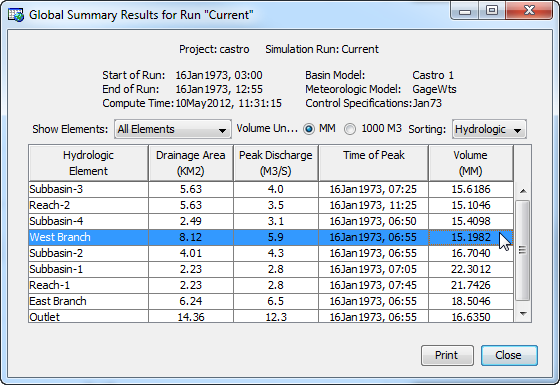
You can choose the units for volume results. Actual volume is shown in either Thousands of Cubic Meters (THOU M3) or in Acre-Feet (AC-FT). You can use the buttons above the table of results to change volume units.
You can view the elements listed either in Alphabetic or Hydrologic order. When hydrologic order is selected, the elements are shown in the same order as in the Watershed Explorer. This order represents the order determined from the flow network plus any manual adjustments. Optionally you can switch to viewing elements in alphabetic order using the selection box above the table of results.
When sediment is enabled for a subbasin and is computed, two additional results columns will appear on the Global Summary Table. Total sediment load (TONNE or TON) and total sediment volume (THOU M3 or ACRE-FT) are listed for each hydrologic element.
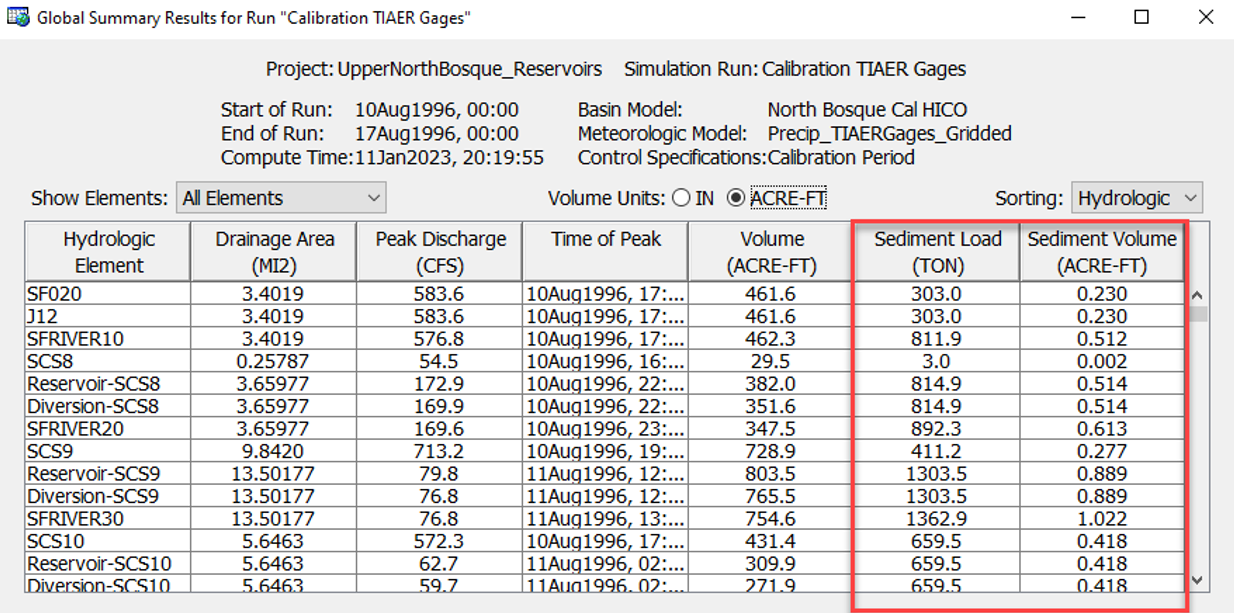
Individual Elements
There are three ways to access results for Individual Elements in the current Simulation Run. All methods show the same results. You must select one or more elements in the Basin Map before you can view results for that element.
The first method for viewing Individual Element Results is to use the Results menu. You may need to first open the Basin Model by clicking on it in the Watershed Explorer, on the Components tab. The current Simulation Run is shown in brackets in the Basin Map Title Bar. Select one or more elements in the Basin Map by clicking with the Arrow Tool. With an element selected in the Basin Map, click the Results menu and select the Element Graph command, the Element Summary Table command, or the Element Time-Series Table command. The appropriate result will automatically be shown in the Desktop area. The information included in the graph varies by element type, but always includes Outflow. Optional items such as Observed Flow, Computed Stage, and Observed Stage are also included.
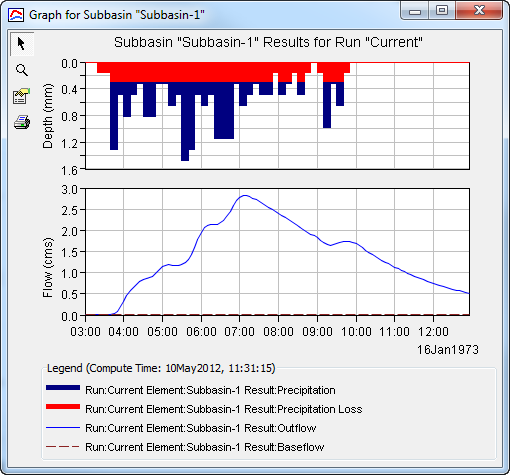
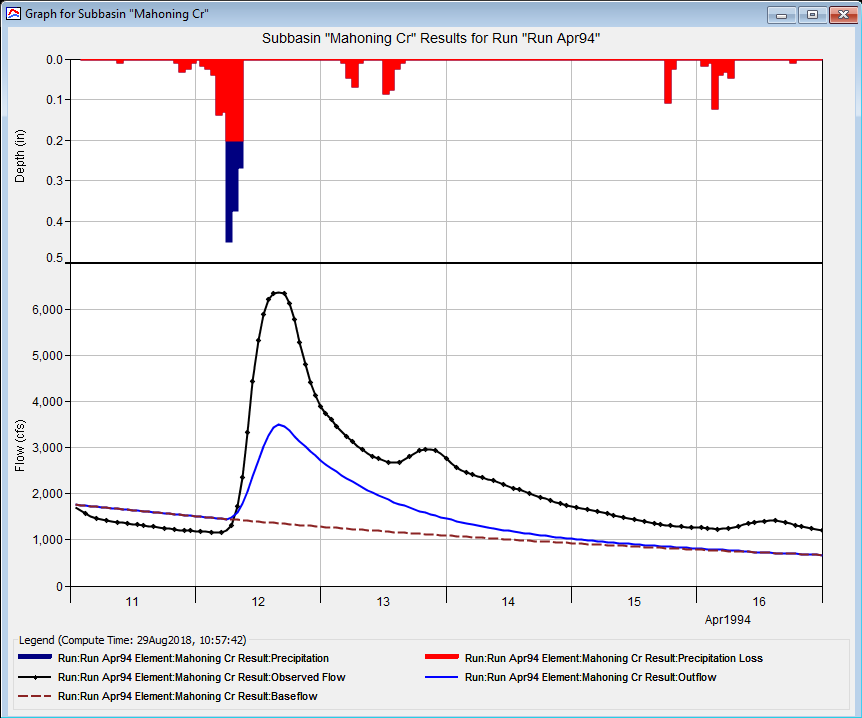
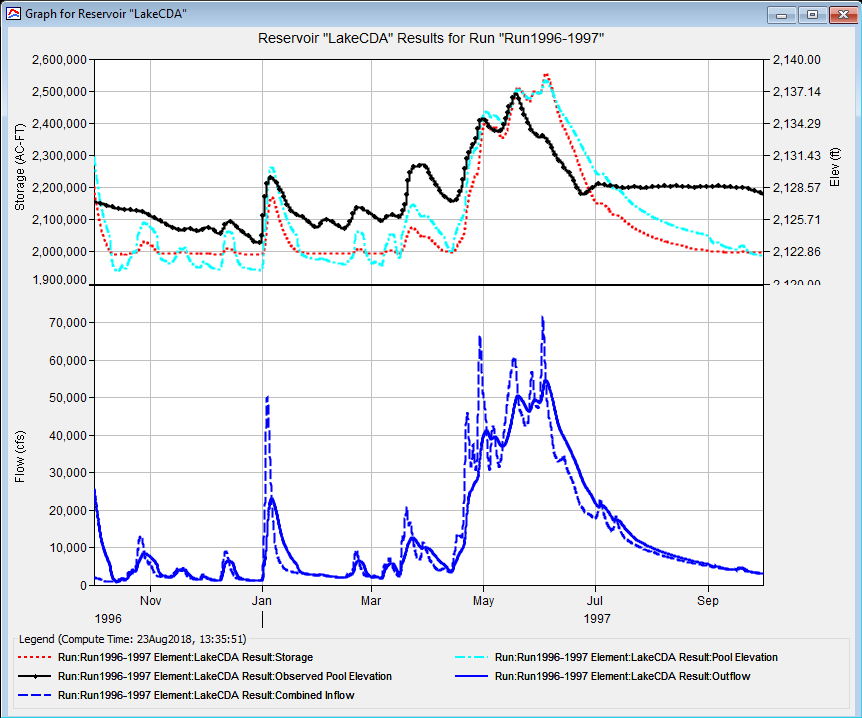
The information included in the Summary Table also varies by element type but always includes the Peak Flow, Time of Peak Flow, and Outflow Volume. If Observed Data are available, then information about the observed data are presented, as well as Goodness-of-Fit Statistics which describe the degree of agreement between the simulated time-series and the observed data. The Time-Series table includes the same information as the graph but in numerical format. If you selected more than one element, then one result for each element will open. The menu commands on the Results menu will only be enabled if the results for the current Simulation Run do not need to be recomputed, and there is an element selection in the Basin Map.


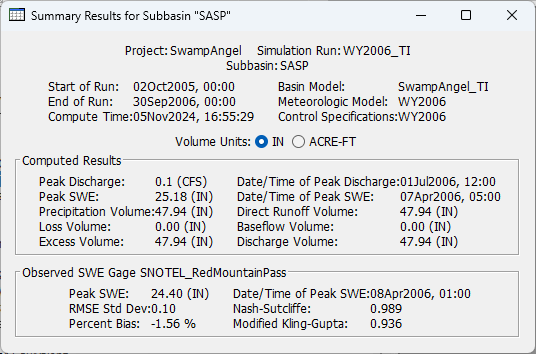
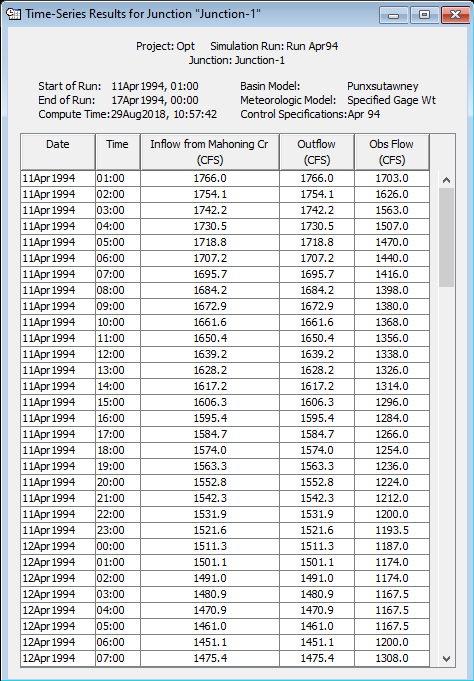
The second method for viewing Individual Element Results is to use the element icon in the Basin Map. Again, you may need to open the Basin Model and select a current Simulation Run before attempting to view results. Click on an element to highlight it. Keep the mouse over the element and press the right mouse button. A context menu is displayed that contains several choices including View Results. The name of the current Simulation Run is shown in brackets after the menu command. Move the mouse into the View Results submenu and select any of the result commands: Graph, Summary Table, or Time-Series Table. The appropriate result will open. If you selected more than one element, then one result for each element will open. The View Results menu command will only be enabled if the results for the current Simulation Run do not need to be recomputed.
The third method for viewing Individual Element Results is to use the Buttons on the Toolbar. First you must open the Basin Model, select a current Simulation Run, and select one or more elements in the basin map by clicking with the arrow tool. Once you have a selected element, click the Graph, Summary Table, or Time-Series Table Buttons. The button for selecting a Graph shows a line plot. The button for the Summary Table shows a plain table. The button for the Time-Series Table shows a table plus a clock. The appropriate result will automatically open. If you selected more than one element, then one result for each element will be added to the Desktop. The toolbar buttons for viewing element results will only be enabled if the results for the current Simulation Run do not need to be recomputed, and there is an element selection in the Basin Map.